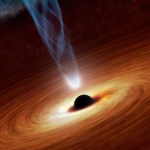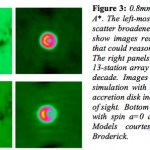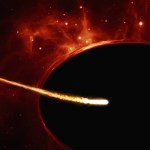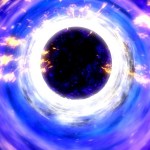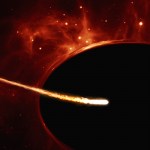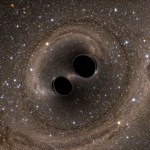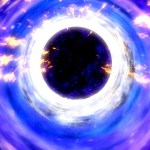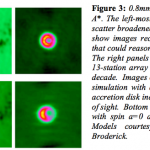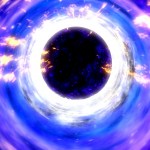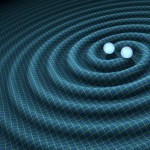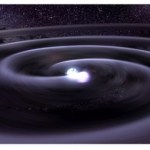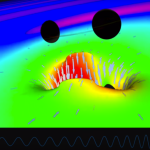Black Holes
“It is conceptually interesting, if not astrophysically very important, to calculate the precise apparent shape of the black hole... Unfortunately, there seems to be no hope of observing this effect.” -Jim Bardeen
Black holes were one of the first consequences of general relativity that were predicted to exist, and the more we’ve studied the Universe, the more interesting they’ve become. We’ve calculated their physical sizes, their effects on the curvature of spacetime, their apparent angular sizes, and the properties of matter that gets caught in an accretion disk around them. But we’re…
“Never look down to test the ground before taking your next step; only he who keeps his eye fixed on the far horizon will find the right road.” -Dag Hammarskjold
One of relativity’s oddest predictions is the existence of black holes, objects so dense and massive that nothing, not event light can escape from them. But that lack-of-escaping is limited to a certain volume of space: that within the black hole’s event horizon. Although black holes have been detected and identified, an event horizon has never yet been imaged. That, however, is likely about to change when the Event Horizon Telescope…
"Put two ships in the open sea, without wind or tide, and, at last, they will come together. Throw two planets into space, and they will fall one on the other. Place two enemies in the midst of a crowd, and they will inevitably meet; it is a fatality, a question of time; that is all." -Jules Verne
When any object passes too close to the event horizon of a black hole, the tidal forces acting on it can become so strong that they’ll tear the entire object apart in a spaghettification disaster. While most of the matter will get ejected from the encounter, a significant fraction can be accreted,…
"Work gives you meaning and purpose and life is empty without it." -Stephen Hawking
Throw a book into a black hole, and the information must somehow wind up inside. Same goes for a star, a planet, or even a single proton: that information must be maintained. But allow enough time to pass, and quantum theory and general relativity, combined, predict something troubling: that black hole will decay, and none of the information will come out in the decay products.
While Einstein's theory makes explicit predictions for a black hole's event horizon and the spacetime just outside, quantum…
"Other galaxies like Andromeda are shooting these ‘spitballs’ at us all the time." -James Guillochon, coauthor on the new study
Imagine you're a star passing too close to a black hole. What's going to happen to you? Yes, you'll be tidally disrupted and eventually torn apart. Some of the matter will be swallowed, some will wind up in an accretion disk, and some will be accelerated and ejected entirely. But quite surprisingly, the ejected matter doesn't just come out in the form of hot gas, but it condenses into large numbers of rapidly-moving planets.
An artist's illustration of large, rapid…
"It's the first time the universe has spoken to us through gravitational waves, up to now we've been deaf to them." -Dave Reitze
No doubt about it: the greatest science advance of 2016 was the end of the century-long wait for the first direct detection of gravitational waves. Not only were we able to detect the inspiral and merger of two black holes from their emission of gravitational waves, we were able to do it more than once. The announcement was a 101-year-after-the-fact confirmation of one of Einstein’s greatest and most unique predictions.
The signal from LIGO of the first robust…
"Even with all the collected data we cannot say with 100% certainty that the ASASSN-15lh event was a tidal disruption event. But it is by far the most likely explanation." -Giorgos Leloudas
Last year, a record-shattering event occurred: we saw the brightest supernova ever observed in the Universe. It outshone the previous record holder by more than double, and it reached a peak brightness of more than 20 times the sum total of all the stars in the Milky Way galaxy. Surprisingly, it occurred in a red, quiet galaxy, rather than the bright blue ones famous for them. After 10 months of follow-up…
"The bedrock nature of space and time and the unification of cosmos and quantum are surely among science's great 'open frontiers.' These are parts of the intellectual map where we're still groping for the truth - where, in the fashion of ancient cartographers, we must still inscribe 'here be dragons.'" -Martin Rees
In 2015, LIGO collected data from a total of three candidate gravitational wave events, all of which were announced and released in 2016. These events verified the great prediction of Einstein: that decaying orbits should emit gravitational radiation with specific magnitudes and…
"I'll never, ever be full. I'll always be hungry. Obviously, I'm not talking about food." -Dwayne 'The Rock' Johnson
Only a very small percentage of galaxies have active supermassive black holes. While the black holes themselves are common, they only rarely feed, gaining a huge influx of matter to accelerate and send jets and other emission out. When a galaxy does become active, they can appear in any number of interesting manifestations, dependent on their orientation relative to us.
The unified model of AGNs/Active Galactic Nuclei. Image credit: Robert Antonucci, aka Ski, of http://web.…
"I think there are a number of experiments that are thinking about how you could look in different frequency bands, and get a glimpse of the primordial gravitational wave background. I think that would be really revolutionary, because that would be your first glimpse at the very first instant of our Universe." -Dave Reitze, LIGO's executive director
Black holes are remarkable entities that have puzzled and fascinated us since they were first postulated long before Einstein developed his theory of relativity. One of their fundamental but bizarre properties is the fact that once something…
“All enterprises that are entered into with indiscreet zeal may be pursued with great vigor at first, but are sure to collapse in the end.” -Tacitus
Dark matter makes up the overwhelming majority of mass in the Universe. With five times as much of it as there is normal matter, and the fact that it doesn’t emit or absorb light but does interact gravitationally, it might seem like the perfect candidate to form black holes. After all, it’s named “dark matter” to begin with, and black holes are perhaps the darkest form of matter in the whole Universe.
While stars might cluster in the disk…
“Man is something that shall be overcome. Man is a rope,tied between beast and overman - a rope over an abyss.What is great in man is that he is a bridge and not an end.” -Friedrich Nietzsche
There are only two types of singularities that General Relativity predicts the existence of in our Universe: one at the centers of black holes, which form from the collapse of matter, and one at the very birth of space and time, at the origin of it all. All of the information that falls into a black hole from our 3D Universe gets encoded on the black hole’s 2D event horizon, which is both fascinating and…
“Never look down to test the ground before taking your next step; only he who keeps his eye fixed on the far horizon will find the right road.” -Dag Hammarskjold
A black hole is a region of space that’s got so much mass in such a small volume that the escape velocity within a specific region is greater than the speed of light. We call this barrier from which light cannot escape the event horizon, and the sole arbiter of an event horizon’s size is the black hole’s mass. Since they come in a variety of sizes and a variety of distances from us, there’s a wide range of the apparent size of the…
"For something to collapse, not all systems have to shut down. In most cases, just one system is enough." -Robert Kiyosaki
Do supermassive black holes form from the merger and growth of many smaller black holes, falling towards a cluster/galactic center where they find one another and grow into a behemoth? Or is there a direct-collapse mechanism at play, where a black hole thousands, tens of thousands or even hundreds of thousands of times the mass of our Sun forms spontaneously?
The X-ray and optical images of a small galaxy containing a black hole many tens of thousands of times the mass…
"Find a place inside where there's joy, and the joy will burn out the pain." -Joseph Campbell
One of the cardinal rules of a black hole is that anything that falls inside the event horizon -- that crosses that invisible boundary -- can never escape. That's because the escape velocity from inside the event horizon is greater than the speed of light in a vacuum, c, a speed that nothing in this Universe can exceed.
In flat space, it's easy to set up an infinite series of observers that all agree on the speed of light at different locations. Image credit: PixaBay user PixelAnarchy.
But in…
"Black holes can bang against space-time as mallets on a drum and have a very characteristic song." -Janna Levin
If you had told an astrophysicist five years ago that binary black holes were common, that would’ve been news, but not surprising. If you had told them that ~30 solar masses was a good estimate for each one of their masses, though, you might have had to pick their jaws up off the floor. Yet LIGO’s very first detection showed us exactly that, much to the surprise of many.
The inspiral and merger of the first pair of black holes ever directly observed. Image credit: B. P. Abbott et…
"We shall not cease from exploration, and the end of all our exploring will be to arrive where we started and know the place for the first time." -T.S. Eliot
Now that not just one but two gravitational wave events have been directly detected, we're officially in the era of true gravitational wave astronomy. LIGO has taught us something unique about stellar mass black holes, and will continue to teach us about these objects, their population statistics, and their merger rates as time goes on.
Image credit: Bohn et al 2015, SXS team, of two merging black holes and how they alter the appearance…
"Mozart's music is like an X-ray of your soul - it shows what is there, and what isn't." -Isaac Stern
When supermassive black holes have a large amount of matter fall onto them, they accelerate a large amount of the ionized material -- particularly electrons -- into high-velocity, bi-directional jets. In many cases, those jets of material collide with previously blown-off gaseous material and create high-energy X-rays.
A black hole more than a billion times the mass of the Sun powers this X-ray jet that's many thousands of light years long. Image credit: NASA / Hubble / STScI / Wikisky tool…
"If you've seen one gamma-ray burst, you've seen one gamma-ray burst!" -Common quote among gamma-ray burst astronomers, emphasizing how little we know about them.
When the first gravitational wave signal ever, GW150914, was directly detected, NASA’s Fermi GBM team shocked the world by announcing the detection of a high-energy burst of electromagnetic radiation. This was a huge surprise, because merging black holes shouldn’t have a bright gamma ray or X-ray flash associated with them!
Image credit: NASA, of an inspiral and merger of two massive, compact objects; illustration only.
A…
"It turned out that nature was very kind, and there appear to be many of these black holes in the Universe and we were lucky enough to see one." -Dave Reitze, executive director of LIGO
On September 14th, 2015, just days after turning on, the twin Advanced LIGO detectors detected the first gravitational wave signature: a merger between two black holes, of 36 and 29 solar masses. They inspiraled, they merged, and they lost 5% of their rest mass to gravitational radiation, sending ripples through the fabric of space due to Einstein’s E = mc^2. It raised a whole slew of questions: were these…
